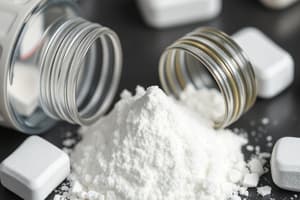Podcast
Questions and Answers
Which law is primarily used to classify elements in the periodic table?
Which law is primarily used to classify elements in the periodic table?
- Moseley's law (correct)
- de Broglie law
- Bohr's model
- Rutherford model
Which of the following describes the structure of an atom?
Which of the following describes the structure of an atom?
- Rutherford model (correct)
- Bohr's model (correct)
- de Broglie law
- Moseley's law
What does de Broglie law primarily address?
What does de Broglie law primarily address?
- Wave-particle duality of matter (correct)
- Periodicity of elements
- Structure of an atom
- Classification of elements
Which model provides a foundation for understanding atomic particles?
Which model provides a foundation for understanding atomic particles?
Which statement is true regarding Moseley's law?
Which statement is true regarding Moseley's law?
What is the concentration of $OH^-$ ions in a solution with a pH of 13?
What is the concentration of $OH^-$ ions in a solution with a pH of 13?
If the pH of a solution is increased from 7 to 13, how does the concentration of $OH^-$ ions change?
If the pH of a solution is increased from 7 to 13, how does the concentration of $OH^-$ ions change?
Which option correctly represents the relationship between pH and pOH in a solution with a pH of 13?
Which option correctly represents the relationship between pH and pOH in a solution with a pH of 13?
What does a higher concentration of $OH^-$ ions indicate about a solution's properties?
What does a higher concentration of $OH^-$ ions indicate about a solution's properties?
If the pH of a solution is decreased from 13 to 12, what would happen to the concentration of $OH^-$ ions?
If the pH of a solution is decreased from 13 to 12, what would happen to the concentration of $OH^-$ ions?
What is the total charge (in coulombs) that has passed through the molten metal salt when a current of 2.0 A is applied for 5 hours?
What is the total charge (in coulombs) that has passed through the molten metal salt when a current of 2.0 A is applied for 5 hours?
Using the given atomic weight and deposited mass of the metal, what is the number of moles of metal deposited?
Using the given atomic weight and deposited mass of the metal, what is the number of moles of metal deposited?
Given the chemical context, what is most likely the oxidation state of the metal in the molten salt if 22 g was deposited?
Given the chemical context, what is most likely the oxidation state of the metal in the molten salt if 22 g was deposited?
If 2.0 A was maintained for 5 hours, how many faradays of charge would correspond to 22 g of the metal deposited?
If 2.0 A was maintained for 5 hours, how many faradays of charge would correspond to 22 g of the metal deposited?
What is the relation between the current passed, time, and the number of moles of metal deposited in this electrochemical process?
What is the relation between the current passed, time, and the number of moles of metal deposited in this electrochemical process?
Flashcards are hidden until you start studying
Study Notes
Calculating Hydroxide Ion Concentration
- The question asks for the concentration of hydroxide ions ($OH^-$) in a solution with a pH of 13.
- The pH scale measures the acidity or alkalinity of a solution.
- A pH of 13 indicates a highly alkaline solution.
- The concentration of hydroxide ions is calculated using the formula: $pOH = -log[OH^-]$
- Since pH + pOH = 14, the pOH of this solution is 1.
- The concentration of hydroxide ions is calculated as 10^{-1} = 0.1 moles/liter.
Moseley's Law
- Moseley's law states that the atomic number of an element is equal to the number of protons in the nucleus of an atom.
- The periodic table is organized by atomic number, which determines the chemical properties of an element.
Determining Oxidation State
- The question involves the electrolysis of a molten metal salt.
- The amount of metal deposited is directly proportional to the amount of electricity passed through the solution.
- The oxidation state of the metal is determined by the number of electrons transferred during the electrolysis process.
- The calculation involves Faraday's law of electrolysis and the formula: $Q = nFt$
- Q is the amount of electricity passed, n is the number of moles of electrons transferred, F is Faraday's constant, and t is the time.
- The number of moles of metal deposited is calculated by dividing the mass of metal by the atomic weight.
- By comparing the number of moles of metal deposited to the number of moles of electrons transferred, the oxidation state of the metal can be determined.
Studying That Suits You
Use AI to generate personalized quizzes and flashcards to suit your learning preferences.




